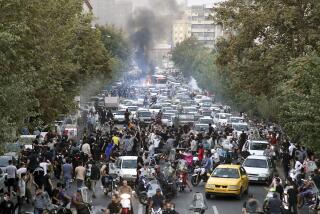Student Militia Reportedly Routs a Top Afghan Faction : War: Shadowy force of Muslim seminarians, veterans a new player in conflict. U.N.-brokered peace plan at risk.
- Share via
NEW DELHI — In a battlefield development that could herald a political and military earthquake in Afghanistan, a recently organized militia of Muslim religious students drove one of the nation’s main warring factions out of its base near Kabul on Tuesday, reports said.
The rout of the fighters of the radical Hezb-i-Islami faction from their headquarters at Charasyab highlights the rapidly growing weight of a new player in Afghanistan’s civil war: the shadowy Taliban militia.
Its rising importance could threaten a U.N.-brokered peace plan that is supposed to go into effect in five days.
The young fundamentalists of the Taliban have not sided with any of the 10 established Afghan factions, accusing them instead of coveting only lucre and power.
The group is somewhat mysterious and is said to be chiefly made up of Afghan refugees recruited from Islamic seminaries in neighboring Pakistan. Some members are battle-hardened veterans who fought the now-defunct pro-Soviet regime. Some reports claim the group is controlled by Pakistan.
Recently, they have swept up from the south, taken the important town of Kandahar and driven northeastward toward Kabul.
The next question is what will happen between now and Monday, when the older warring Islamic factions plan to form a multi-party governing council that will succeed President Burhanuddin Rabbani. A nationwide cease-fire is supposed to follow.
But units of the Taliban have not agreed to participate in the council.
“This should make the peace talks more urgent. All parties now feel threatened by the Taliban,” Mahmood Mestiri, the head of the U.N. peace mission to Afghanistan, told the Associated Press in a telephone interview.
The Taliban’s latest victory came at the expense of Afghan opposition leader Gulbuddin Hekmatyar. He has been locked in a murderous power struggle with Rabbani since Islamic moujahedeen guerrillas moved into Kabul after the collapse of the Communist government in April, 1992.
A spokesman for Hekmatyar’s Hezb-i-Islami group told the Reuters news agency that it had given up the Charasyab headquarters, nine miles south of Kabul, and the eastern province of Logar, in the face of what he called a combined attack by the Taliban and pro-Rabbani forces.
The spokesman, Qaribur Rehman Saeed, called it a “tactical retreat.”
Hekmatyar reported by radio that he and his fighters had fled to the town of Sarobi, about 37 miles east of Kabul, Saeed said.
The fall of the Hezb-i-Islami base could only delight residents of Kabul, because Hekmatyar’s fighters had used Charasyab to conduct frequent mortar, rocket and artillery bombardments of government-held parts of the capital.
A Rabbani spokesman said government forces now occupy most positions around Kabul previously held by Hezb-i-Islami.
The situation on the ground, however, was not clear. Western journalists who visited Charasyab to confirm the reports of its fall saw Taliban militiamen disarming pro-Rabbani fighters there.
That added to the uncertainty about what the Taliban fighters intend to do next. Some commanders have said they intend to march on Kabul. But Abdullah, a Rabbani spokesman, said he was sure the group would not turn its guns on the Rabbani-led government.
More to Read
Sign up for Essential California
The most important California stories and recommendations in your inbox every morning.
You may occasionally receive promotional content from the Los Angeles Times.













